2005 JEEP LIBERTY load capacity
[x] Cancel search: load capacityPage 159 of 424
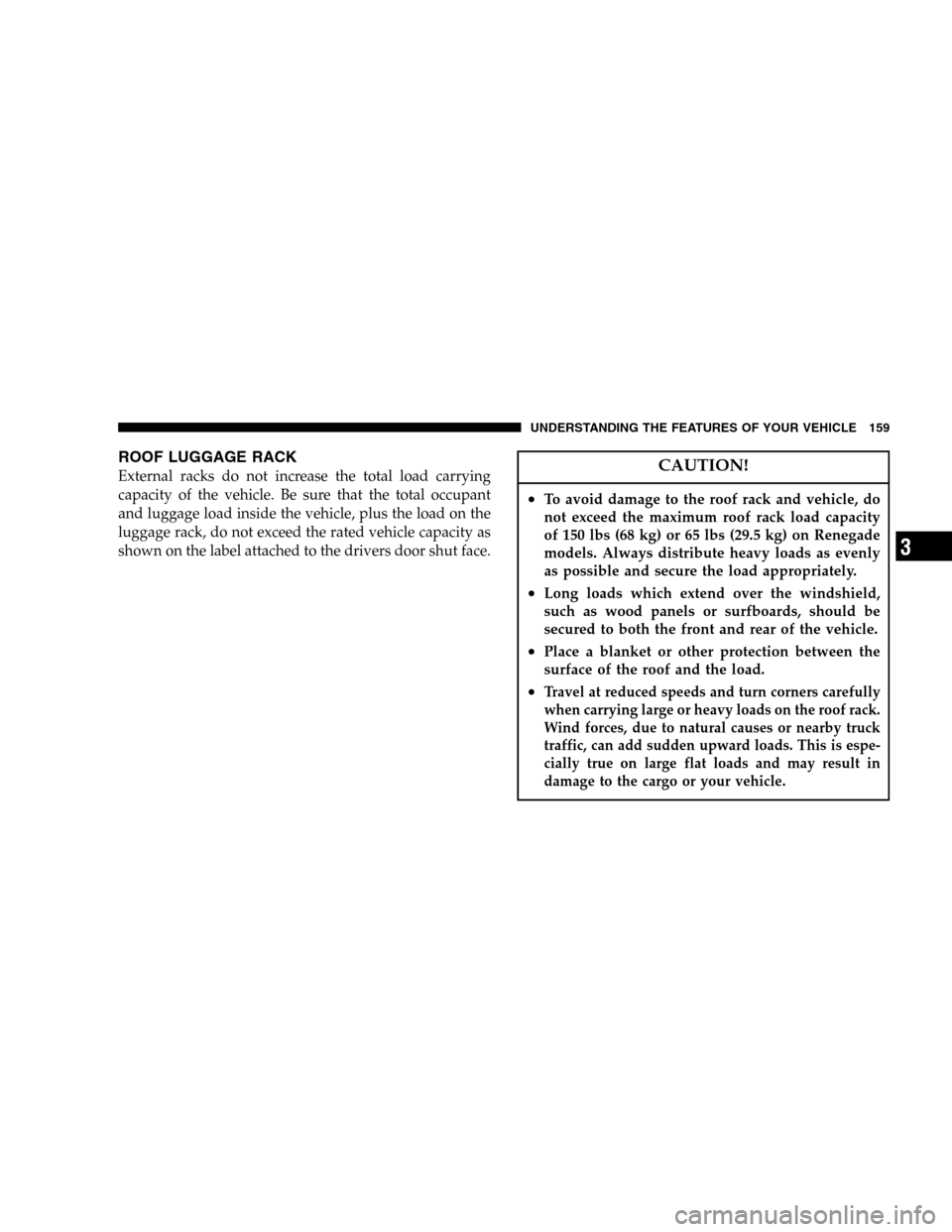
ROOF LUGGAGE RACK
External racks do not increase the total load carrying
capacity of the vehicle. Be sure that the total occupant
and luggage load inside the vehicle, plus the load on the
luggage rack, do not exceed the rated vehicle capacity as
shown on the label attached to the drivers door shut face.CAUTION!
•To avoid damage to the roof rack and vehicle, do
not exceed the maximum roof rack load capacity
of 150 lbs (68 kg) or 65 lbs (29.5 kg) on Renegade
models. Always distribute heavy loads as evenly
as possible and secure the load appropriately.
•Long loads which extend over the windshield,
such as wood panels or surfboards, should be
secured to both the front and rear of the vehicle.
•Place a blanket or other protection between the
surface of the roof and the load.
•Travel at reduced speeds and turn corners carefully
when carrying large or heavy loads on the roof rack.
Wind forces, due to natural causes or nearby truck
traffic, can add sudden upward loads. This is espe-
cially true on large flat loads and may result in
damage to the cargo or your vehicle.
UNDERSTANDING THE FEATURES OF YOUR VEHICLE 159
3
Page 259 of 424
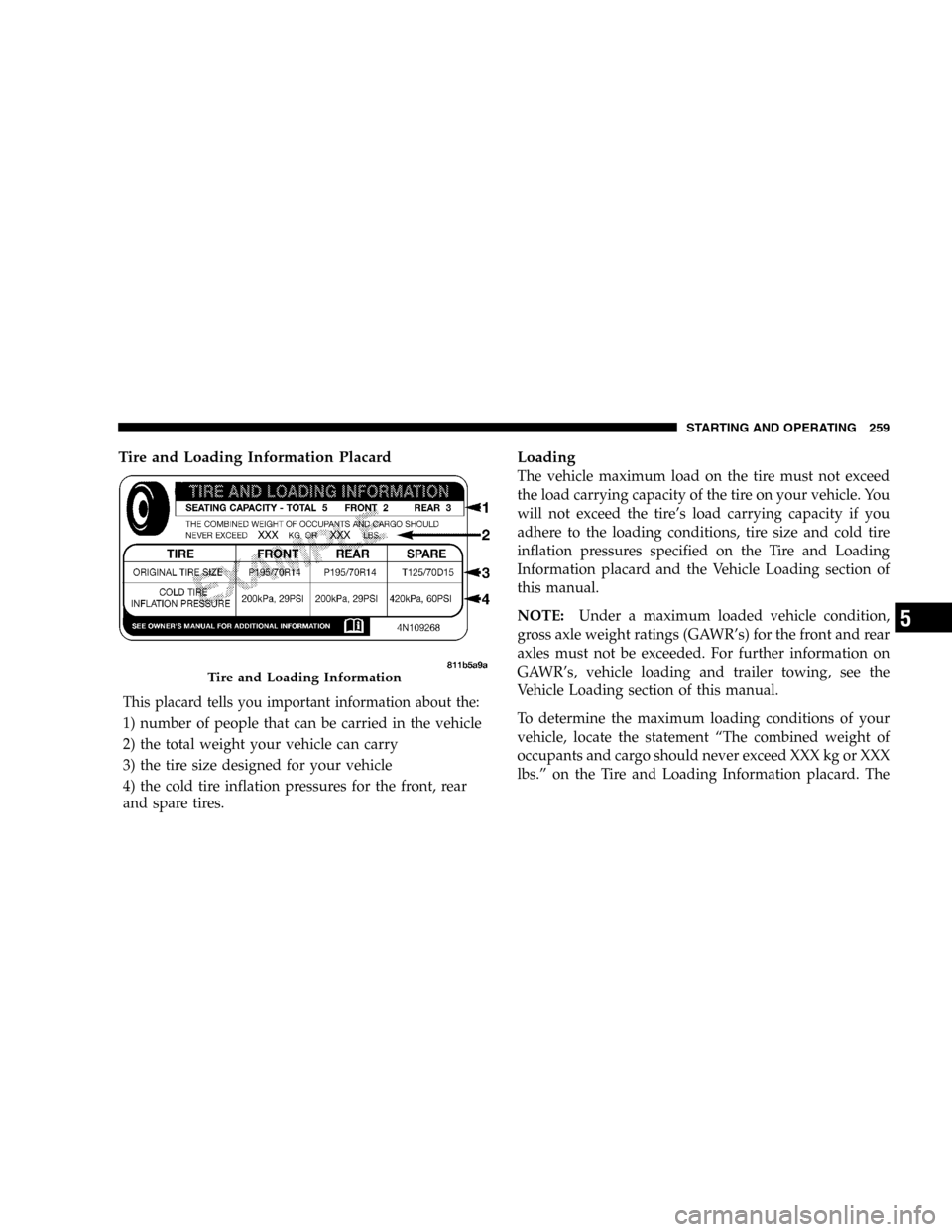
Tire and Loading Information Placard
This placard tells you important information about the:
1) number of people that can be carried in the vehicle
2) the total weight your vehicle can carry
3) the tire size designed for your vehicle
4) the cold tire inflation pressures for the front, rear
and spare tires.
Loading
The vehicle maximum load on the tire must not exceed
the load carrying capacity of the tire on your vehicle. You
will not exceed the tire’s load carrying capacity if you
adhere to the loading conditions, tire size and cold tire
inflation pressures specified on the Tire and Loading
Information placard and the Vehicle Loading section of
this manual.
NOTE:Under a maximum loaded vehicle condition,
gross axle weight ratings (GAWR’s) for the front and rear
axles must not be exceeded. For further information on
GAWR’s, vehicle loading and trailer towing, see the
Vehicle Loading section of this manual.
To determine the maximum loading conditions of your
vehicle, locate the statement “The combined weight of
occupants and cargo should never exceed XXX kg or XXX
lbs.” on the Tire and Loading Information placard. The
Tire and Loading Information
STARTING AND OPERATING 259
5
Page 260 of 424
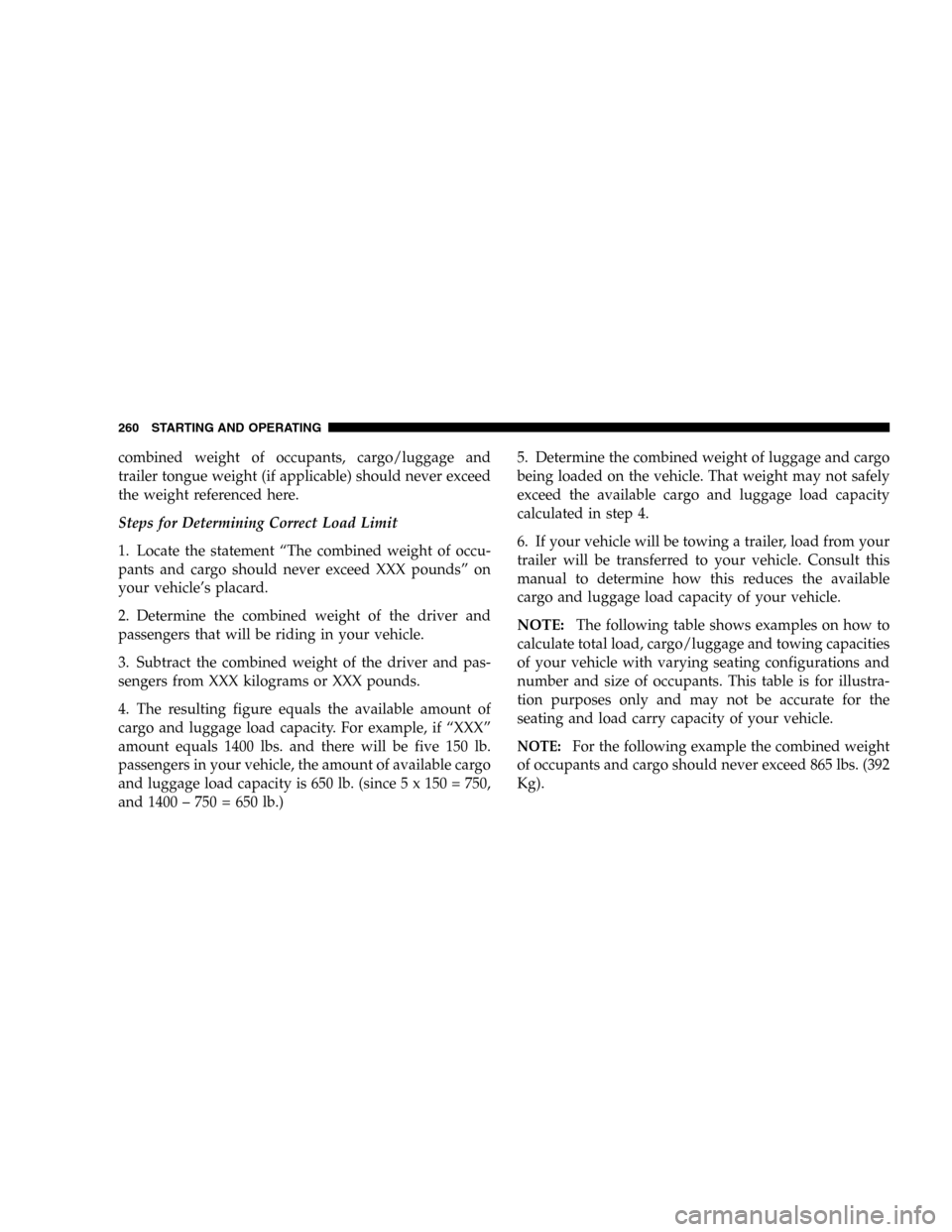
combined weight of occupants, cargo/luggage and
trailer tongue weight (if applicable) should never exceed
the weight referenced here.
Steps for Determining Correct Load Limit
1. Locate the statement “The combined weight of occu-
pants and cargo should never exceed XXX pounds” on
your vehicle’s placard.
2. Determine the combined weight of the driver and
passengers that will be riding in your vehicle.
3. Subtract the combined weight of the driver and pas-
sengers from XXX kilograms or XXX pounds.
4. The resulting figure equals the available amount of
cargo and luggage load capacity. For example, if “XXX”
amount equals 1400 lbs. and there will be five 150 lb.
passengers in your vehicle, the amount of available cargo
and luggage load capacity is 650 lb. (since 5 x 150 = 750,
and 1400 – 750 = 650 lb.)5. Determine the combined weight of luggage and cargo
being loaded on the vehicle. That weight may not safely
exceed the available cargo and luggage load capacity
calculated in step 4.
6. If your vehicle will be towing a trailer, load from your
trailer will be transferred to your vehicle. Consult this
manual to determine how this reduces the available
cargo and luggage load capacity of your vehicle.
NOTE:The following table shows examples on how to
calculate total load, cargo/luggage and towing capacities
of your vehicle with varying seating configurations and
number and size of occupants. This table is for illustra-
tion purposes only and may not be accurate for the
seating and load carry capacity of your vehicle.
NOTE:For the following example the combined weight
of occupants and cargo should never exceed 865 lbs. (392
Kg).
260 STARTING AND OPERATING
Page 262 of 424

WARNING!
Overloading of your tires is dangerous. Overloading
can cause tire failure, affect vehicle handling, and
increase your stopping distance. Use tires of the
recommended load capacity for your vehicle. Never
overload them.
TIRES — GENERAL INFORMATION
Proper tire inflation pressure is essential to the safe and
satisfactory operation of your vehicle. Three primary
areas are affected by improper tire pressure:1. Safety—
WARNING!
Improperly inflated tires are dangerous and can
cause accidents.
•Under inflation increases tire flexing and can
result in tire failure.
•Over inflation reduces a tire’s ability to cushion
shock. Objects on the road and chuck holes can cause
damage that results in tire failure.
•Unequal tire pressures can cause steering prob-
lems. You could lose control of your vehicle.
•Overinflated or under inflated tires can affect
vehicle handling and can fail suddenly, resulting in
loss of vehicle control.
Always drive with each tire properly inflated.
262 STARTING AND OPERATING
Page 264 of 424
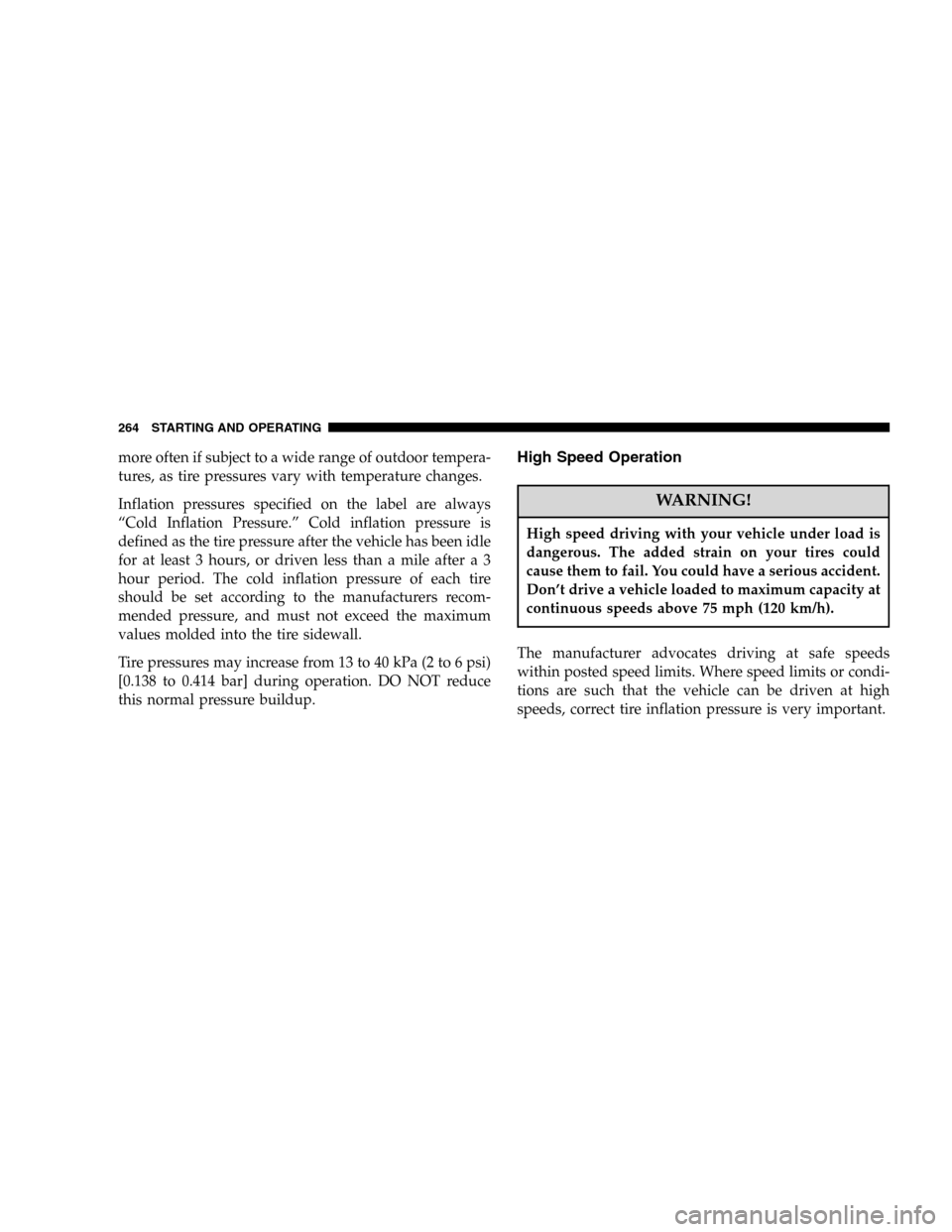
more often if subject to a wide range of outdoor tempera-
tures, as tire pressures vary with temperature changes.
Inflation pressures specified on the label are always
“Cold Inflation Pressure.” Cold inflation pressure is
defined as the tire pressure after the vehicle has been idle
for at least 3 hours, or driven less than a mile after a 3
hour period. The cold inflation pressure of each tire
should be set according to the manufacturers recom-
mended pressure, and must not exceed the maximum
values molded into the tire sidewall.
Tire pressures may increase from 13 to 40 kPa (2 to 6 psi)
[0.138 to 0.414 bar] during operation. DO NOT reduce
this normal pressure buildup.High Speed Operation
WARNING!
High speed driving with your vehicle under load is
dangerous. The added strain on your tires could
cause them to fail. You could have a serious accident.
Don’t drive a vehicle loaded to maximum capacity at
continuous speeds above 75 mph (120 km/h).
The manufacturer advocates driving at safe speeds
within posted speed limits. Where speed limits or condi-
tions are such that the vehicle can be driven at high
speeds, correct tire inflation pressure is very important.
264 STARTING AND OPERATING
Page 267 of 424
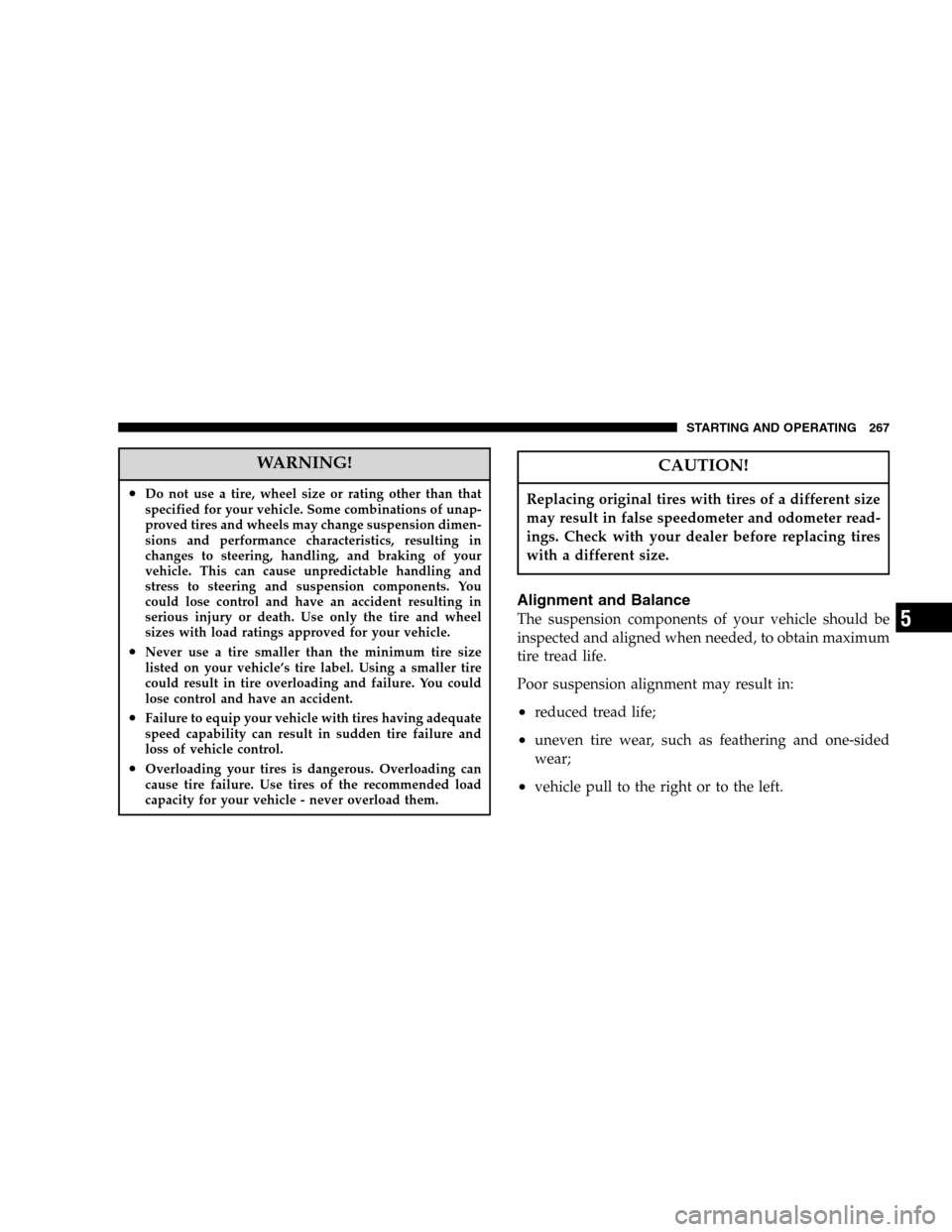
WARNING!
•Do not use a tire, wheel size or rating other than that
specified for your vehicle. Some combinations of unap-
proved tires and wheels may change suspension dimen-
sions and performance characteristics, resulting in
changes to steering, handling, and braking of your
vehicle. This can cause unpredictable handling and
stress to steering and suspension components. You
could lose control and have an accident resulting in
serious injury or death. Use only the tire and wheel
sizes with load ratings approved for your vehicle.
•Never use a tire smaller than the minimum tire size
listed on your vehicle’s tire label. Using a smaller tire
could result in tire overloading and failure. You could
lose control and have an accident.
•Failure to equip your vehicle with tires having adequate
speed capability can result in sudden tire failure and
loss of vehicle control.
•Overloading your tires is dangerous. Overloading can
cause tire failure. Use tires of the recommended load
capacity for your vehicle - never overload them.
CAUTION!
Replacing original tires with tires of a different size
may result in false speedometer and odometer read-
ings. Check with your dealer before replacing tires
with a different size.
Alignment and Balance
The suspension components of your vehicle should be
inspected and aligned when needed, to obtain maximum
tire tread life.
Poor suspension alignment may result in:
•reduced tread life;
•uneven tire wear, such as feathering and one-sided
wear;
•vehicle pull to the right or to the left.
STARTING AND OPERATING 267
5
Page 285 of 424
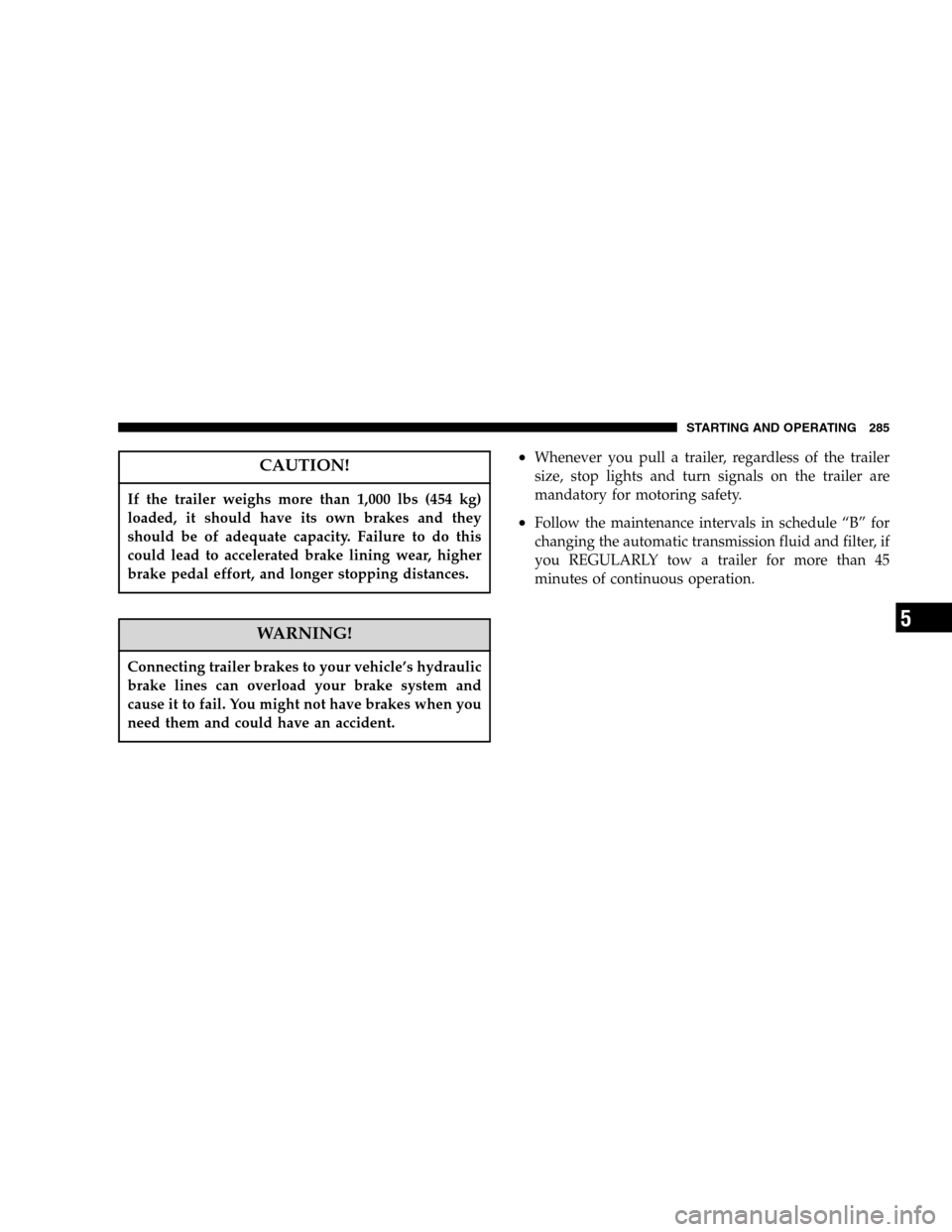
CAUTION!
If the trailer weighs more than 1,000 lbs (454 kg)
loaded, it should have its own brakes and they
should be of adequate capacity. Failure to do this
could lead to accelerated brake lining wear, higher
brake pedal effort, and longer stopping distances.
WARNING!
Connecting trailer brakes to your vehicle’s hydraulic
brake lines can overload your brake system and
cause it to fail. You might not have brakes when you
need them and could have an accident.
•Whenever you pull a trailer, regardless of the trailer
size, stop lights and turn signals on the trailer are
mandatory for motoring safety.
•Follow the maintenance intervals in schedule “B” for
changing the automatic transmission fluid and filter, if
you REGULARLY tow a trailer for more than 45
minutes of continuous operation.
STARTING AND OPERATING 285
5
Page 415 of 424

Timing Belt............................ 319
Tire and Loading Information Placard......258,259
Tire Identification Number (TIN)............. 257
Tire Markings.......................... 254
Tire Safety Information.................... 254
Tires ................................. 262
Air Pressure.......................... 263
Alignment and Balance.................. 267
Chains.............................. 274
Changing............................ 294
General Information.................... 262
High Speed.......................... 264
Inflation Pressures..................... 263
Jacking............................. 294
Load Capacity.....................258,259
Pressure Monitor System................. 268
Radial.............................. 265
Replacement......................... 266
Rotation............................. 275Safety............................75,254
Sizes............................... 255
Spare Tire........................... 295
Spinning............................ 265
Tread Wear Indicators................... 266
Torque Converter Clutch.................. 235
Tow Hooks, Emergency................... 301
Towing............................283,302
Disabled Vehicle....................... 302
Recreational.......................... 287
Trailering............................ 283
Trac-Lok Rear Axle...................... 245
Trailer Towing.......................... 283
Minimum Requirements................. 286
Transfer Case........................236,336
Four-Wheel-Drive Operation.............. 236
Maintenance.......................... 336
Transmission
Automatic........................230,333
INDEX 415
10